deeplearninghandbook
Lecture Slides and Programming Exercises that may help study the deep learning book by Goodfellow, Bengio and Courville.
Assignment 5 - Multi-layer Perceptrons
Learning XOR
Can linear regression solve the XOR problem?
$\theta = (X^TX)^{-1}(X^Ty)$
import numpy as np
x = np.array ( [ [1, 0, 1], [0, 1, 1], [0, 0, 1], [1, 1, 1]] )
y = np.array ( [1, 1, 0, 0] )
# solve using normal equations:
x_transpose = np.transpose(x) #calculating transpose
x_transpose_dot_x = x_transpose.dot(x) # calculating dot product
temp_1 = np.linalg.inv(x_transpose_dot_x) #calculating inverse
temp_2 = x_transpose.dot(y)
theta = temp_1.dot(temp_2)
theta
# Result: w = [0,0] b = 0.5 => y = 0.5 everywhere!
array([0.00000000e+00, 2.22044605e-16, 5.00000000e-01])
# solve using neural network with one hidden layer
def g(x):
return np.maximum(x, 0) # relu
x = np.array ( [ [1, 0], [0, 1], [0, 0], [1, 1]] )
print(x)
W = np.array ( [[1,1], [1,1]]);
c = [0, -1]
w = np.array ( [1, -2] )
b = 0
h = g(x.dot(W) + c )
print (h)
y = h.dot(w) + b
print (y)
import matplotlib.pyplot as plt
plt.subplot(121)
plt.scatter (x[:,0],x[:,1],c=y)
plt.subplot(122)
plt.scatter (h[:,0],h[:,1],c=y)
plt.plot ([0,2],[0,1],'r-')
[[1 0]
[0 1]
[0 0]
[1 1]]
[[1 0]
[1 0]
[0 0]
[2 1]]
[1 1 0 0]
[<matplotlib.lines.Line2D at 0x7ff7b9c6efd0>]
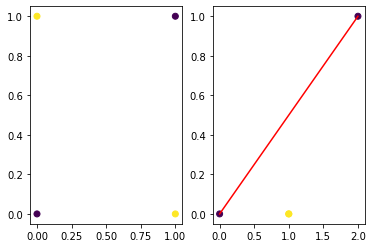
Ex I
(a) Find W, c, w, b using gradient-based learning for the above network. You can use pytorch, tensorflow, keras, or others
(b) have you found the same parameters as for the solution given above?
(c) Design neural networks to model an AND gate, OR gate, NAND gate, and make them learn the weights
Gradient-Based Learning
In this exercise, we aim at learning the precision of a Conditional Gaussian distribution using a simple neural network.
We fix $x$, and generate values from $N(y, mu, sigma)$
Loss function: $-\frac{1}{2} log \beta + \frac{1}{2} \beta (y -\mu)^2 $
import numpy as np
import keras.backend as K
def loss(y, beta):
return -K.log(beta) + beta * (y - mean)**2
# build a neural network using keras
from keras.models import Sequential
from keras.layers import Dense
from keras import optimizers
from keras.initializers import RandomUniform, RandomNormal, Zeros, Ones, Constant
model = Sequential()
# model.add(Dense(1, input_dim=1, activation='relu'))
model.add(Dense(1, input_dim=1, activation='softplus')) # In addition, we can set kernel_initializer and bias_initializer
# we want the network to output beta
# important: if we use RELU, we do not want to start with a 0 gradient since we will get stuck.
# It is important to initialize w and b (and even x) to not have wx+b < 0 as a start!
# Another way is to use softplus since it always outputs a positive value
model.summary()
Model: "sequential_2"
Layer (type) Output Shape Param #
=================================================================
dense_2 (Dense) (None, 1) 2
=================================================================
Total params: 2
Trainable params: 2
Non-trainable params: 0
import math
mean = 0
sigma = 1/math.sqrt(5)
# extrem cases to try :
# -- sigma very large
# sigma = 1000 # precision very small => very large gradients (1/0)
# -- sigma very small
# sigma = 0.0001 # precision very large
true_beta= 1.0 / sigma**2 # 1 / 5 = 0.20
x = np.random.uniform(0,1,1000)
y = np.random.normal(mean, sigma, 1000)
print (true_beta)
# reinitialize weights
session = K.get_session()
for layer in model.layers: # 1 layer : output layer
if hasattr(layer, 'kernel_initializer'):
layer.kernel.initializer.run(session=session)
if hasattr(layer, 'bias_initializer'):
layer.bias.initializer.run(session=session)
model.compile(loss=loss, optimizer=optimizers.sgd(lr=0.01,clipnorm=1)) #clipnorm=1 for beta very small
print ("Weights before learning: ", model.layers[0].get_weights()[0], model.layers[0].get_weights()[1])
history = model.fit(x, y, epochs=300, batch_size=64, verbose=0)
print ("Weights after learning: ", model.layers[0].get_weights()[0], model.layers[0].get_weights()[1])
res = model.predict(x[0:1]) # approximation of beta
print (res)
import matplotlib.pyplot as plt
print (history.history.keys())
fig = plt.figure()
plt.plot(history.history['loss'])
plt.title('loss')
plt.ylabel('loss')
plt.xlabel('Epoch')
plt.legend(['loss'], loc='upper left')
plt.show()
5.0
Weights before learning: [[1.0865592]] [0.]
Weights after learning: [[2.3530436]] [3.6423688]
[[5.665899]]
dict_keys([‘loss’])
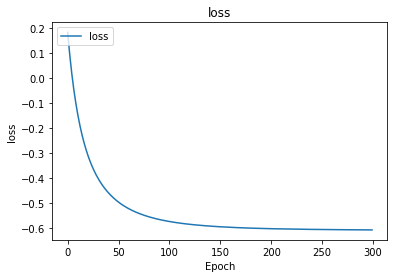
# why softplus?
t = np.arange(-5., 5., 0.1)
plt.plot(t, np.log(1+np.exp(t)), 'g-')
[<matplotlib.lines.Line2D at 0x7ff77014c710>]
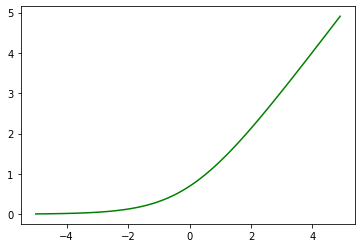
Ex 2
(a) Extend the previous exercise to a two dimensional input $(x_1, x_2)$ with two variances $(\sigma_1^2, \sigma_2^2)$.
We assume that the input variables are not correlated.
(b) Similar to the exercise above (gradient-based learning), design a neural network that learns the 3 means of a Gaussian mixture with 3 components
- Assume $x$ is one dimensional
- $ p(y|x) $ is a gaussian mixture of three components
- Assume that the three components are equally likely
- Assume all variances are 1
Hidden units
Sigmoid vs. Hyperbolic
import numpy as np
import matplotlib.pyplot as plt
t = np.arange(-5., 5., 0.1)
plt.plot(t, np.tanh(t), 'g-', label='tanh')
plt.plot(t, 1/(1+np.exp(-t)), 'b-', label='sigmoid')
plt.legend()
<matplotlib.legend.Legend at 0x7ff770129dd8>
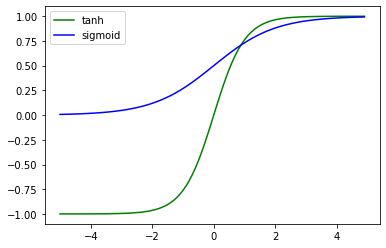
Absolute value rectifier unit
import numpy as np
import matplotlib.pyplot as plt
t1 = np.arange(-5., 0.1, 0.1)
t2 = np.arange(0, 5, 0.1)
plt.plot(t1, -t1, 'g-', t2, t2, 'b-')
[<matplotlib.lines.Line2D at 0x7ff77009cf60>,
<matplotlib.lines.Line2D at 0x7ff7700aa0b8>]
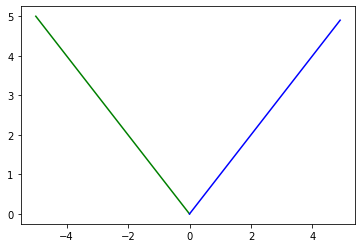
##Backprop
Let’s reconsider the problem of learning the variance, and implement gradient-based learning from scratch without recurring to Keras. It means that we have to implement forward prop and backprop.
Loss function: $- log \beta + \beta (y -\mu)^2 $
Forward propagation: \(a = w x + b\) \(\beta = relu (a)\) \(L = - log \beta + \beta (y -\mu)^2\)
Backward propagation: \(\frac {\delta L } {\delta \beta} = -\frac{1}{\beta} + (y-\mu)^2\)
\[\frac {\delta L } {\delta a} = \begin{cases} \frac {\delta L } {\delta \beta} * 1 & if a > 0 \\ \frac {\delta L } {\delta \beta} * 0 & if a < 0 \\ \end{cases}\] \[\frac{\delta L } {\delta w} = \frac {\delta L } {\delta a} x\] \[\frac{\delta L } {\delta b} = \frac {\delta L } {\delta a} 1\]import math
import numpy as np
w = 0.01 # initial w
b = 0 # initial b
x = 1 # input to conition on
sigma = math.sqrt(10) # std deviation of the conditional distribution p(y|x=1)
mu = 0 # for simplicity, we take mu = 0
true_beta = 1 / sigma**2 # true precision to guess
eps = 0.0001 # learnign rate
y = np.random.normal(0, sigma, 1000) # sample y from the Gaussian to use as labels
# y
# implement forward propagation
def forward (w,b):
a = w * x + b
beta = np.maximum (a, 0)
L = -np.log(beta) + beta * sum ( (y-mu)**2 ) /len(y)
return a, beta, L
# implement backward propagation
def backward(beta, a):
delta_L_to_beta = -1/beta + sum ( (y - mu)**2 ) / len (y)
if a > 0:
delta_L_to_a = delta_L_to_beta
else:
delta_L_to_a = 0
delta_L_to_w = delta_L_to_a * x
delta_L_to_b = delta_L_to_a
return delta_L_to_w, delta_L_to_b
# implement gradient descent
print('w \t\t\t b \t\t\t a \t\t beta \t\t true_beta')
for i in range(1000):
a, beta, L = forward (w,b)
if i%100==0:
print (w, b, a, beta, true_beta)
delta_L_to_w, delta_L_to_b = backward(beta, a)
w = w - eps * delta_L_to_w
b = b - eps * delta_L_to_b
w b a beta true_beta
0.01 0 0.01 0.01 0.09999999999999998
0.0523793852703444 0.0423793852703444 0.09475877054068879 0.09475877054068879 0.09999999999999998
0.05446046083942835 0.04446046083942835 0.09892092167885669 0.09892092167885669 0.09999999999999998
0.054718267549679574 0.04471826754967957 0.09943653509935915 0.09943653509935915 0.09999999999999998 0.05475158042935688 0.044751580429356876 0.09950316085871375 0.09950316085871375 0.09999999999999998
0.054755907453349364 0.04475590745334936 0.09951181490669872 0.09951181490669872 0.09999999999999998
0.054756469870038814 0.04475646987003881 0.09951293974007763 0.09951293974007763 0.09999999999999998
0.05475654297805371 0.04475654297805371 0.09951308595610742 0.09951308595610742 0.09999999999999998
0.05475655248140337 0.04475655248140337 0.09951310496280674 0.09951310496280674 0.09999999999999998
0.05475655371675065 0.04475655371675065 0.09951310743350131 0.09951310743350131 0.09999999999999998
The problem with Relu
The network with Relu can step into regions where log is not defined.
It needs good initialization and very small learning step
For example, consider for instance the case where w = 0.1, the gradient step can easily project the b into the infeasible region.
import matplotlib.pyplot as plt
fig = plt.figure(figsize=(10,10))
baxis = np.linspace(0.00000001, 0.1, 100)
a, beta, L = forward(0.1 * np.ones(baxis.shape), baxis)
plt.plot(baxis, L, 'g-', label='w=0.1' )
a, beta, L = forward(0.05 * np.ones(baxis.shape), baxis)
plt.plot(baxis, L, 'b-', label='w=0.05' )
a, beta, L = forward(0.01 * np.ones(baxis.shape), baxis)
plt.plot(baxis, L, 'r-', label='w=0.01' )
fig.gca().set_title("$Loss (b)$", position=(0.5,0.9))
plt.legend()
<matplotlib.legend.Legend at 0x7ff7700aaf60>
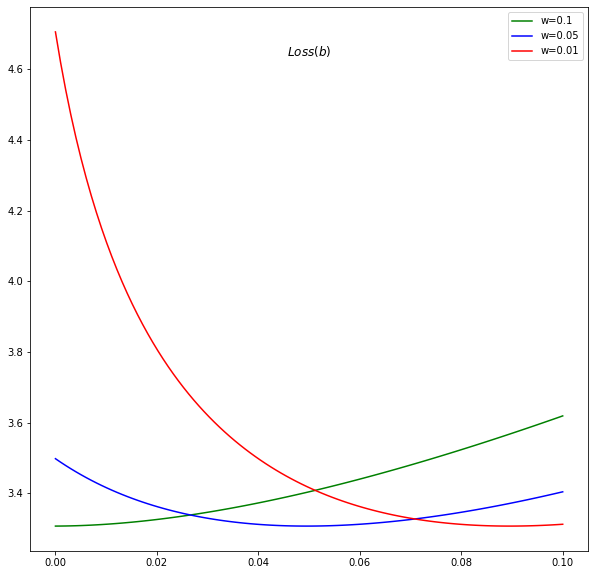
Why softmax would work?
We plot the loss function in terms of w and b when using the softplus activation.
import numpy as np
import matplotlib.pyplot as plt
from mpl_toolkits.mplot3d import Axes3D
%matplotlib inline
x = 1
mu = 0
fig = plt.figure(figsize=(27,9))
def forward (theta, y):
a = theta[0] * x + theta[1]
beta = np.log(1+np.exp(a)) # softplus
L = -np.log(beta) + beta * (sum (y-mu)**2 /len(y))
return L
waxis = np.linspace(-10, 10, 100)
baxis = np.linspace(-10, 10, 100)
X, Y = np.meshgrid(waxis, baxis)
C = np.c_[(X.ravel(), Y.ravel())]
## Normal case: sigma is of moderate value
sigma = math.sqrt(10)
true_beta = 1 / sigma**2
y = np.random.normal(0, sigma, 1000)
L = np.array([forward (C[i], y) for i in range (len(C))])
L = L.reshape(X.shape)
ax = fig.add_subplot(131, projection='3d')
ax.plot_surface(X,Y,L)
ax.set_xlabel('$w$')
ax.set_ylabel('$b$')
ax.set_zlabel('$Loss$')
# ax.set_xlim(-10,10)
# ax.set_ylim(10,-10)
ax.set_title('$L_{softmax}(w,b)$')
## Extreme case: sigma very high
sigma = 10000
true_beta = 1 / sigma**2
y = np.random.normal(0, sigma, 1000)
L = np.array([forward (C[i], y) for i in range (len(C))])
L = L.reshape(X.shape)
ax = fig.add_subplot(132, projection='3d')
ax.plot_surface(X,Y,L)
ax.set_xlabel('$w$')
ax.set_ylabel('$b$')
ax.set_zlabel('$Loss$')
# ax.set_xlim(-10,10)
# ax.set_ylim(10,-10)
ax.ticklabel_format(style='plain')
ax.set_title('$L_{softmax}(w,b)$ \n notice the sharp descent / z-axis scale' )
## Extreme case: sigma very low
sigma = 10**-4
true_beta = 1 / sigma**2
y = np.random.normal(0, sigma, 1000)
L = np.array([forward (C[i], y) for i in range (len(C))])
L = L.reshape(X.shape)
ax = fig.add_subplot(133, projection='3d')
ax.plot_surface(X,Y,L)
ax.set_xlabel('$w$')
ax.set_ylabel('$b$')
ax.set_zlabel('$Loss$')
# ax.set_xlim(-10,10)
# ax.set_ylim(10,-10)
ax.set_title('$L_{softmax}(w,b)$ \n notice the slow descent / z-axis scale' )
Text(0.5, 0.92, '$L_{softmax}(w,b)$ \n notice the slow descent / z-axis scale')

Ex 3
(a) Implement backward propagation and gradient descent for the example with softplus
(b) Implement forward propagation, backprop and gradient descent for part a) or part b) of Ex 2. (You choose).